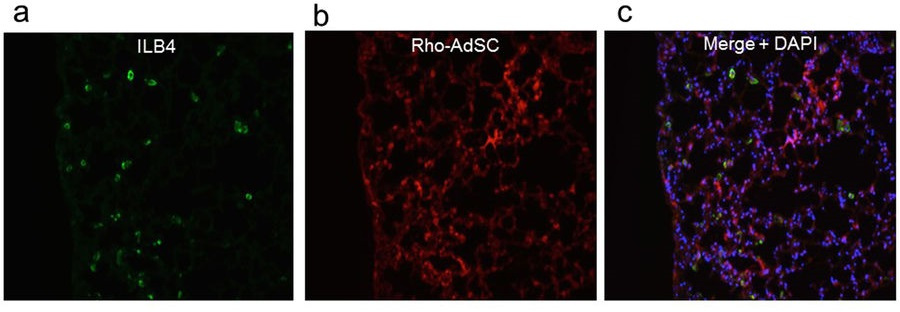ブレイオマイシン誘発間質性肺炎マウスモデルにおける脂肪由来幹細胞静脈内投与による抗炎症性作用と抗繊維化作用
Anti-inflammatory and anti-fibrotic effects of intravenous adipose-derived stem cell transplantation in a mouse model of bleomycin-induced interstitial pneumonia
2017年11月3日 Scientific Reports 7 : 14608 doi: 10.1038/s41598-017-15022-3

近年、脂肪由来幹細胞(AdSC)は、その抗炎症性および抗繊維化作用から、自己免疫疾患に対する有用な治療ツールと考えられている。我々は、ブレイオマイシン誘発間質性肺炎マウスモデルにおいて、AdSCの静脈内投与による治療効果を調べた。AdSCは肺の間質に集積し、炎症と繊維化のいずれも抑制し、ブレイオマイシン誘発間質性肺炎マウスの生存率を細胞数依存的に改善した。AdSCは、活性化マクロファージにおけるTNF-αやIL-12などの炎症性サイトカインの産生を抑制するだけでなく、活性化マクロファージのアポトーシスも誘導した。AdSCはTh2型mCD4+T細胞の分化と増殖を抑制する一方で、制御性T細胞の分化と増殖を促進することから、T細胞の形質転換が、肺間質でのAdSCの抗炎症作用機構の一つであると考えられる。これらの知見は、AdSCの静脈内投与が間質性肺炎患者にとって有望な治療になる可能性を示唆している。
Corresponding Author
Adipose-derived stem cells (AdSCs) have recently been considered a useful treatment tool for autoimmune disease because of their anti-inflammatory and immunosuppressive effects. We investigated the therapeutic effect of intravenous AdSC transplantation in a mouse model of bleomycin-induced lung injury. AdSCs accumulated in the pulmonary interstitium and inhibited both inflammation and fibrosis in the lung, markedly improving the survival rate of mice with bleomycin-induced lung injury in a cell number-dependent manner. AdSCs inhibited the production of pro-inflammatory cytokines such as TNF-α and IL-12 in activated macrophages, and AdSCs also induced the apoptosis of activated macrophages. AdSCs inhibited the differentiation and proliferation of Th2-type mCD4+ T cells but promoted the differentiation and proliferation of regulatory T cells, suggesting that the phenotypic conversion of T cells may be one of the mechanisms for the anti-inflammatory effect of AdSCs on pulmonary fibrosis. These findings suggest that intravenous AdSCs could be a promising treatment for patients with interstitial pneumonia.

